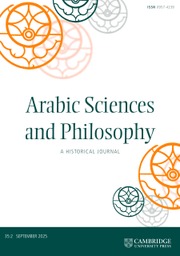Article contents
AL-ĠAZĀLĪ'S CONCEPT OF PROPHECY: THE INTRODUCTION OF AVICENNAN PSYCHOLOGY INTO Aš‘ARITE THEOLOGY
Published online by Cambridge University Press: 01 March 2004
Extract
The traditional argument of Muslim theologians that aims to verify the claims of a true prophet and distinguish him from an impostor is based on the acceptance of miracles performed in history and testified through an uninterrupted chain of tradition (tawātur). A second argument that equally involves transmission through tawātur is based on the prophet’s virtuous and impeccable character establishing the trustworthiness (sidq) of the prophet. These are, for instance, the types of proofs (singl. huˇgˇga) mentioned by the Baghdadian Mu‘tazilī al-Gˇāhiz (d. 255/869) in his monograph Huˇgaˇg al-nubuwwa. For theologians of the Aš‘arite school this approach to the verification of prophecy posed a problem. According to classical Aš‘arite theology, good is what God commands and bad is what he forbids. If God chooses prophets to reveal knowledge about what is right and what is wrong, and thus also reveal knowledge about how to live a virtuous life, how can those whom the prophets call upon know that the prophets have a virtuous character before they even know the criteria for virtue? Early Aš‘arite theologians indeed accepted that all prophets had a most virtuous character. This fact, however, became apparent only after their message gained acceptance within their community and it cannot be regarded as a viable verification of the claim of a prophet to those he calls upon. Al-Aš‘arī (d. 324/935), for instance, is said to have accepted a number of indications that allow humans to distinguish a prophet from ordinary people. He does not mention the claim based on the impeccable moral conduct of prophets. In fact, he stresses that in order to distinguish a true prophet from other people who are close to God (awliyā'), but who have no message to reveal, one should put oneÕs trust only in the occurrence of true prophetic miracles.
- Type
- Research Article
- Information
- Copyright
- © 2004 Cambridge University Press
- 21
- Cited by


